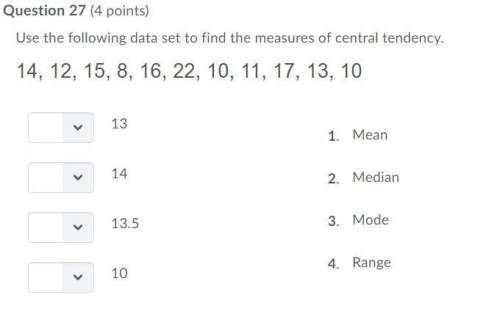
Mathematics, 08.03.2021 20:20 arianayoung
it's clear that this course teaches a combination of analytical and Euclidean geometry. based on your experiences so far, which approach to geometry do you prefer? why? which approach is easier to extend beyond two dimensions? what are some situations in which one approach to geometry would prove more beneficial than the other? describe the situation and why you think analytical or euclidean geometry is more applicable. discussion topic

Answers: 2


Another question on Mathematics

Mathematics, 21.06.2019 16:30
Determine whether the quadrilateral below is a parallelogram. justify/explain your answer (this means back it up! give specific information that supports your decision. writing just "yes" or "no" will result in no credit.)
Answers: 2

Mathematics, 21.06.2019 20:30
Asmall business produces and sells balls. the fixed costs are $20 and each ball costs $4.32 to produce. each ball sells for $8.32. write the equations for the total cost, c, and the revenue, r, then use the graphing method to determine how many balls must be sold to break even.
Answers: 1

Mathematics, 21.06.2019 21:40
Write the contrapositive of the conditional statement. determine whether the contrapositive is true or false. if it is false, find a counterexample. a converse statement is formed by exchanging the hypothesis and conclusion of the conditional. a) a non-converse statement is not formed by exchanging the hypothesis and conclusion of the conditional. true b) a statement not formed by exchanging the hypothesis and conclusion of the conditional is a converse statement. false; an inverse statement is not formed by exchanging the hypothesis and conclusion of the conditional. c) a non-converse statement is formed by exchanging the hypothesis and conclusion of the conditional. false; an inverse statement is formed by negating both the hypothesis and conclusion of the conditional. d) a statement not formed by exchanging the hypothesis and conclusion of the conditional is not a converse statement. true
Answers: 1

Mathematics, 21.06.2019 23:00
Each of the following data sets has a mean of x = 10. (i) 8 9 10 11 12 (ii) 7 9 10 11 13 (iii) 7 8 10 12 13 (a) without doing any computations, order the data sets according to increasing value of standard deviations. (i), (iii), (ii) (ii), (i), (iii) (iii), (i), (ii) (iii), (ii), (i) (i), (ii), (iii) (ii), (iii), (i) (b) why do you expect the difference in standard deviations between data sets (i) and (ii) to be greater than the difference in standard deviations between data sets (ii) and (iii)? hint: consider how much the data in the respective sets differ from the mean. the data change between data sets (i) and (ii) increased the squared difference îł(x - x)2 by more than data sets (ii) and (iii). the data change between data sets (ii) and (iii) increased the squared difference îł(x - x)2 by more than data sets (i) and (ii). the data change between data sets (i) and (ii) decreased the squared difference îł(x - x)2 by more than data sets (ii) and (iii). none of the above
Answers: 2
You know the right answer?
it's clear that this course teaches a combination of analytical and Euclidean geometry. based on you...
Questions

History, 24.06.2019 05:30



History, 24.06.2019 05:30




English, 24.06.2019 05:30


Mathematics, 24.06.2019 05:30


Social Studies, 24.06.2019 05:30

Mathematics, 24.06.2019 05:30

History, 24.06.2019 05:30


Computers and Technology, 24.06.2019 05:30


Health, 24.06.2019 05:30

Mathematics, 24.06.2019 05:30

History, 24.06.2019 05:30




